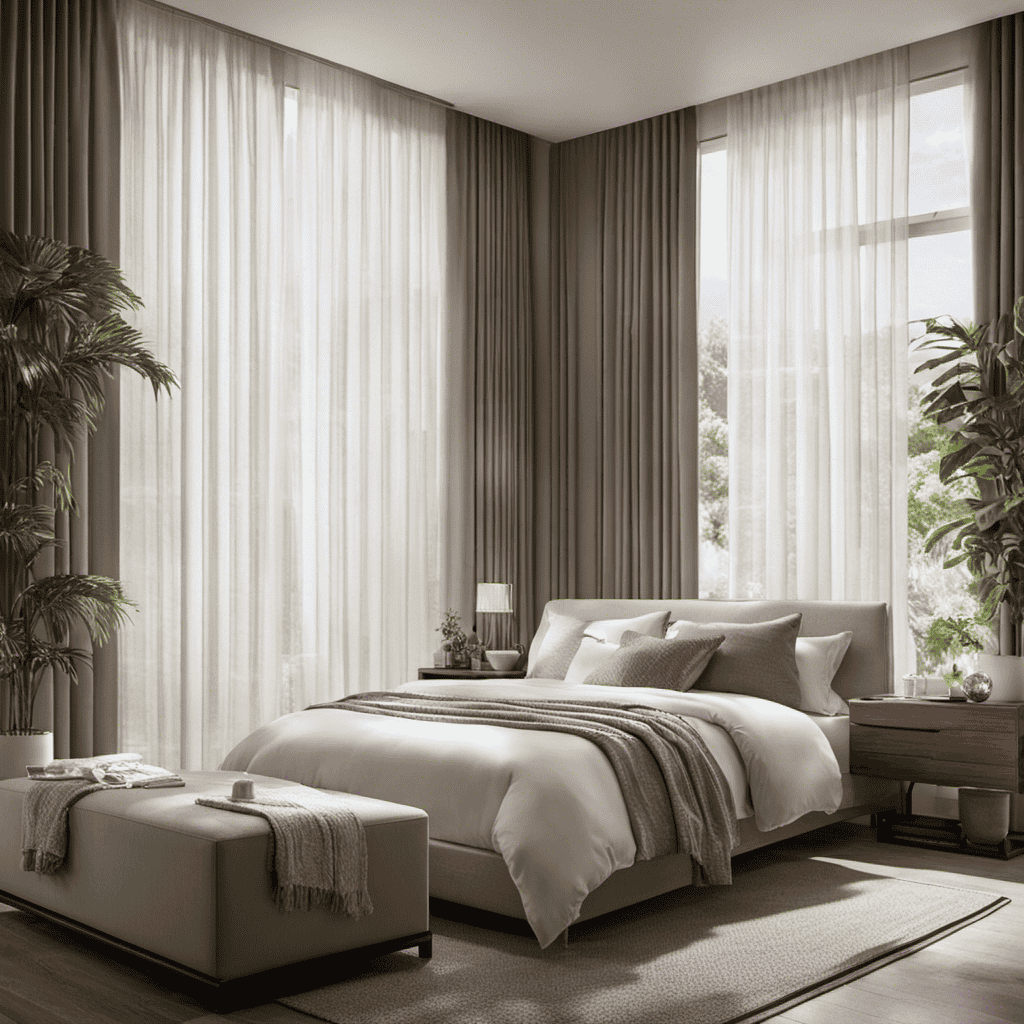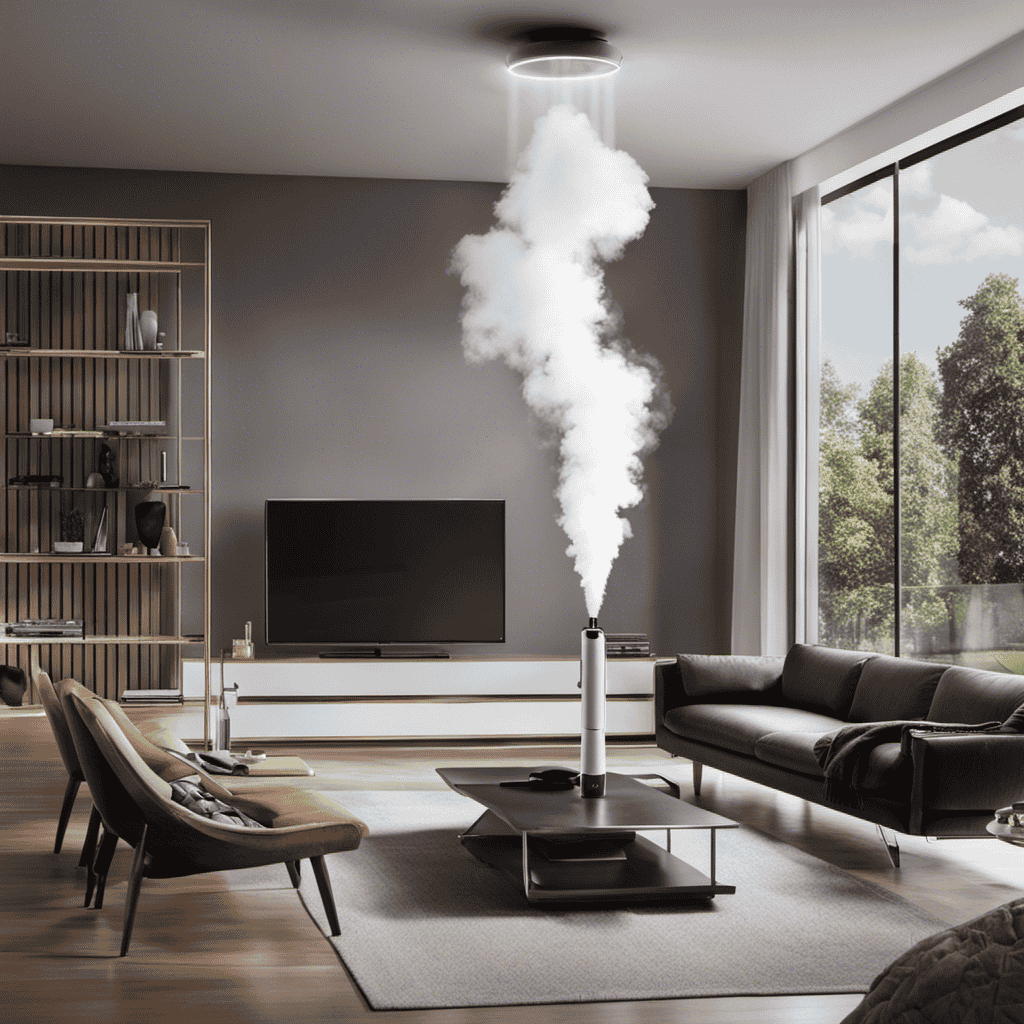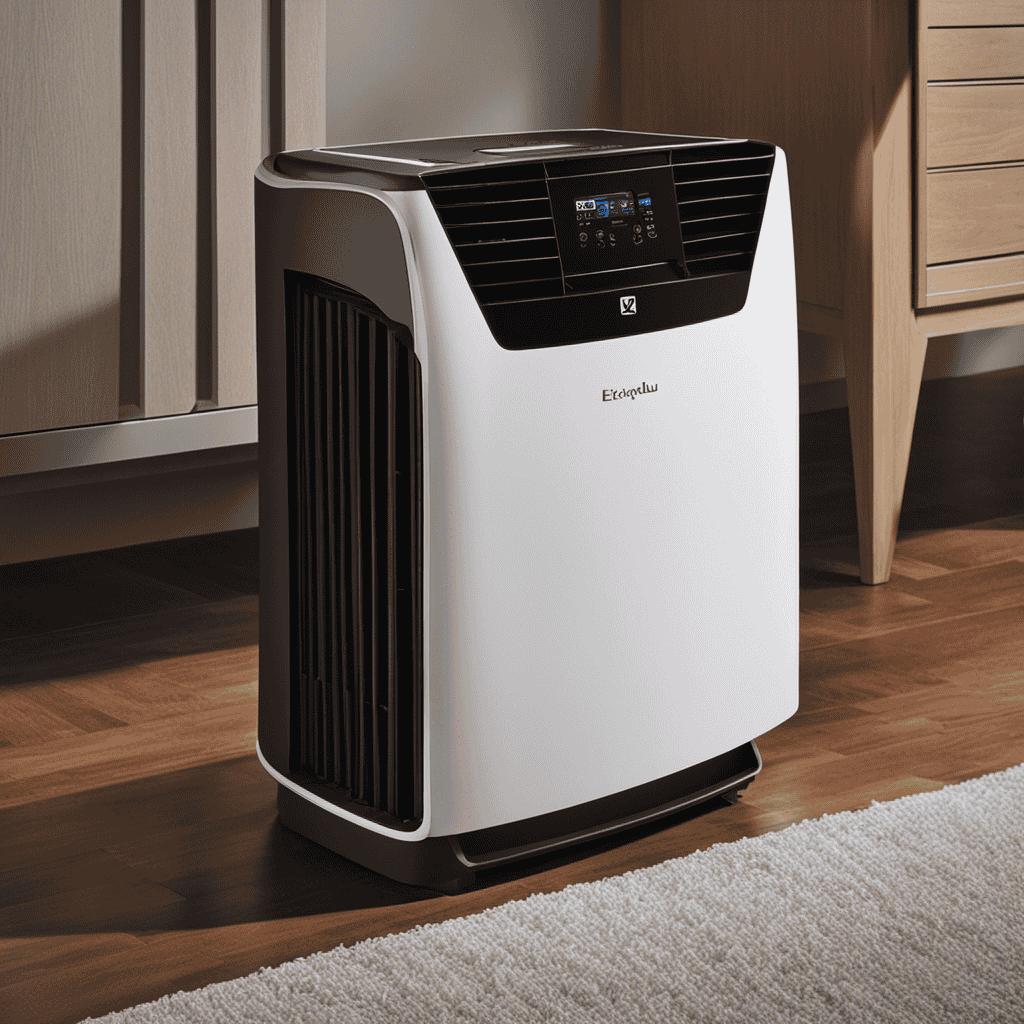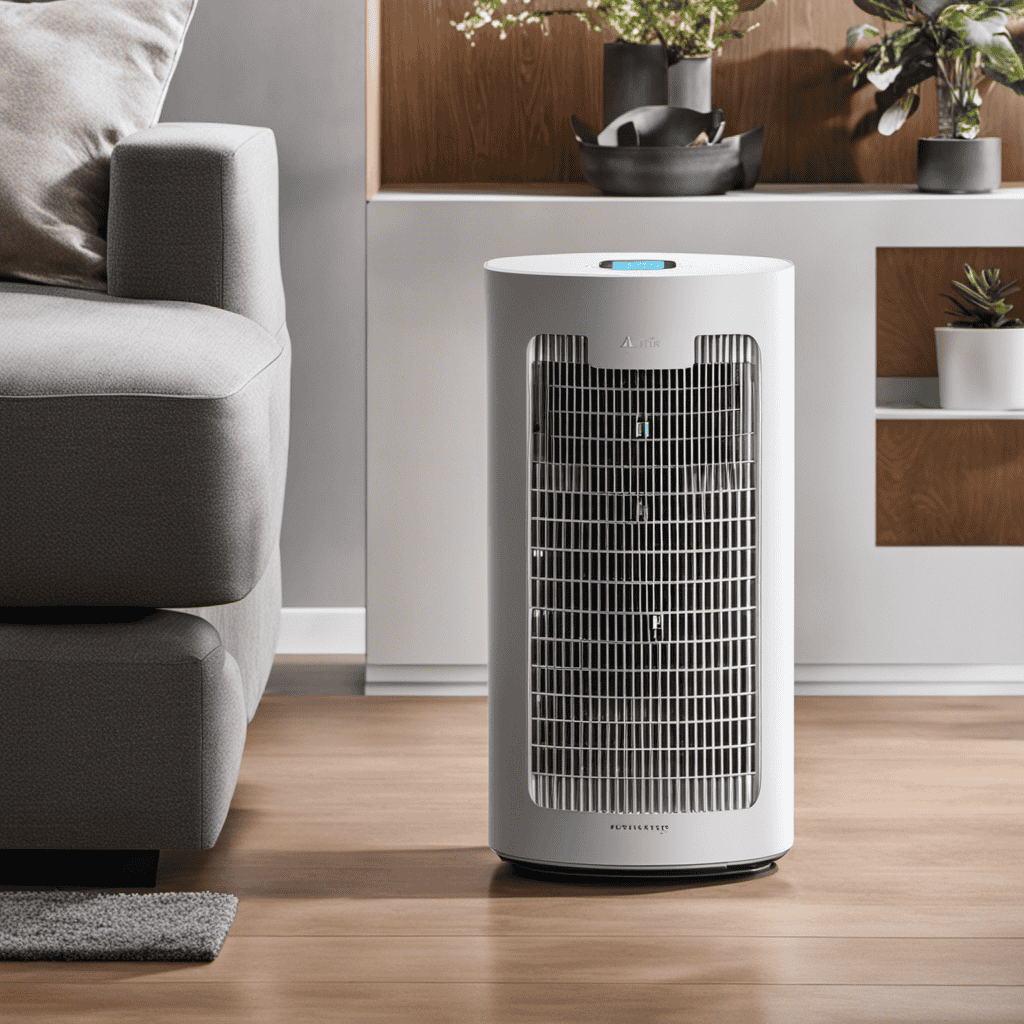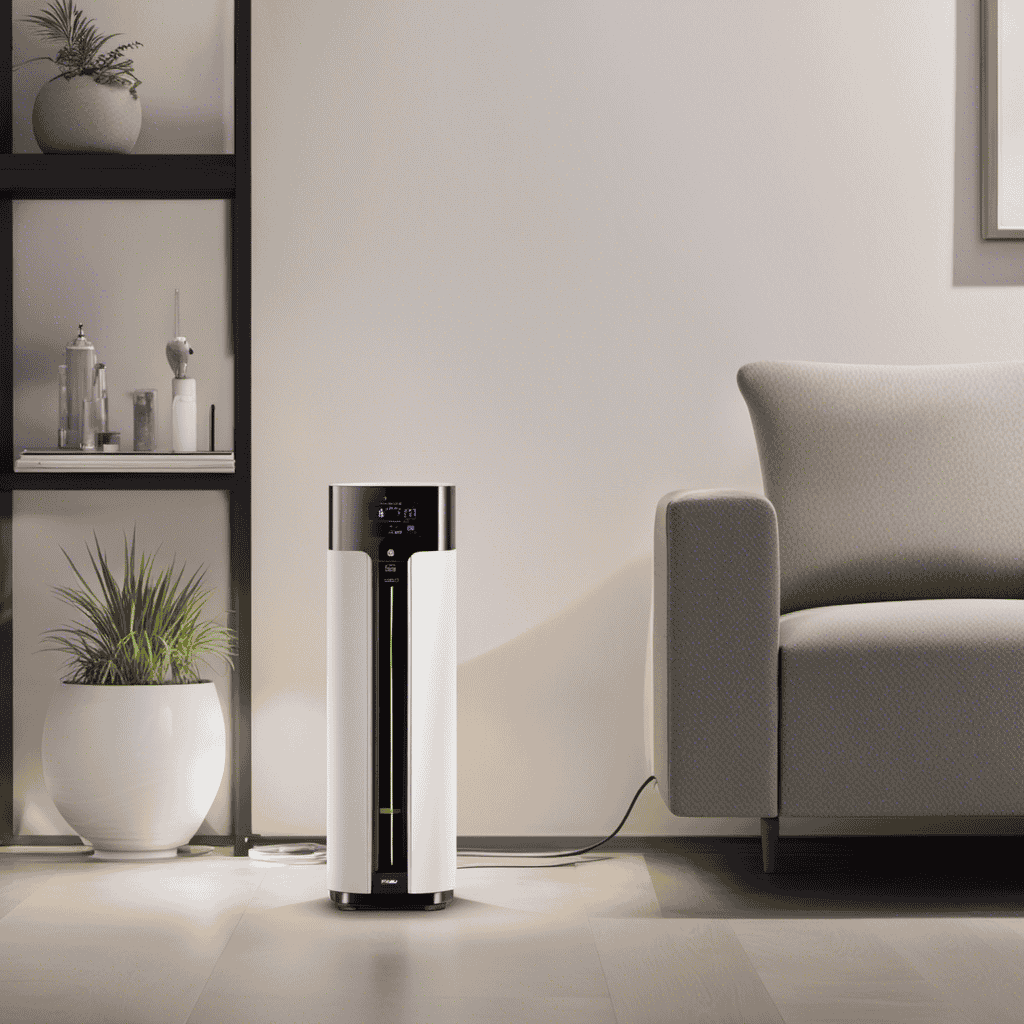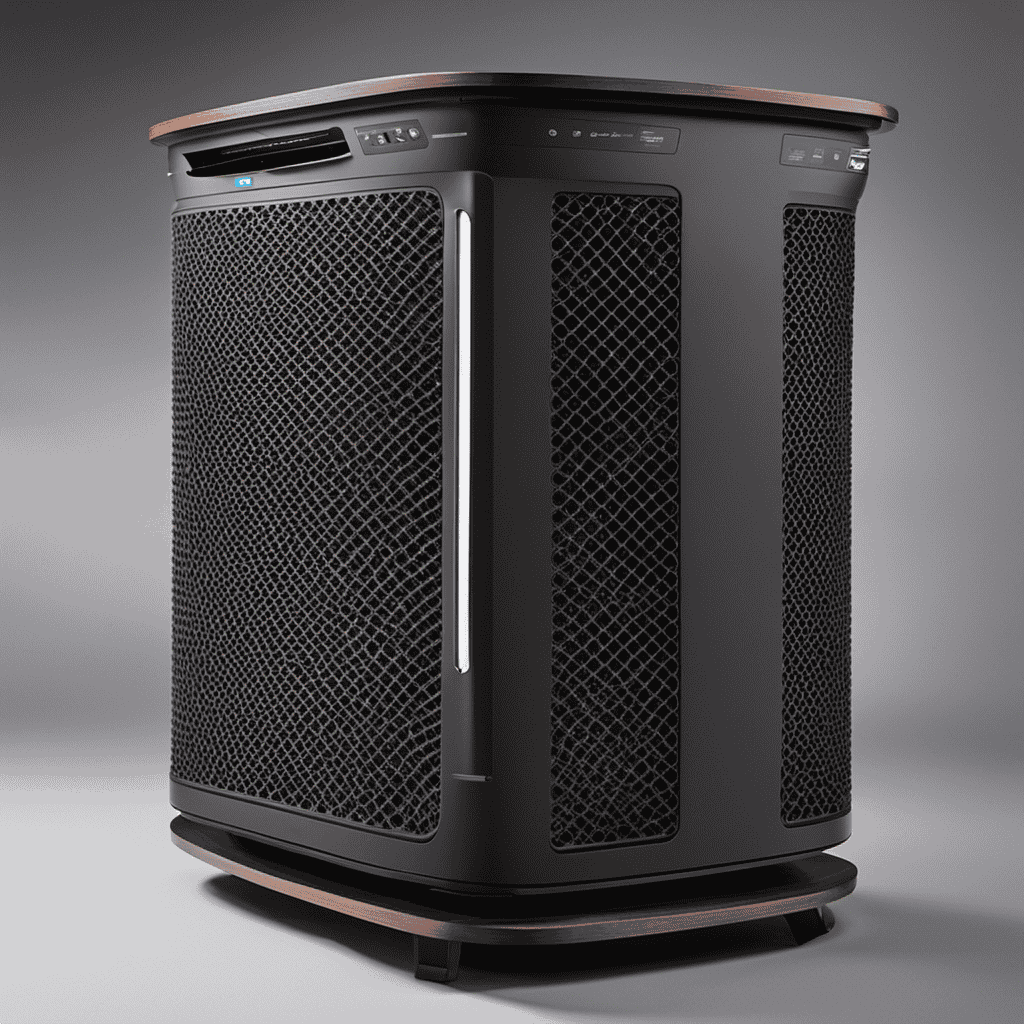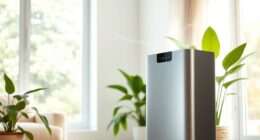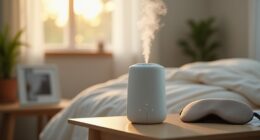I understand your dilemma – determining the optimal setting for your air purifier can seem daunting given the variety of choices available. It’s not always clear which selection is the superior one.
But fear not, because in this article, I’ll guide you through the ins and outs of air purifier settings. We’ll discuss factors to consider, such as room size and allergens, and help you find the perfect balance between energy efficiency and performance.
So let’s dive in and find the optimal setting for your air purifier!
Key Takeaways
- Different air purifier settings serve different purposes.
- The low setting is suitable for small rooms, while the high setting is more effective for larger spaces or high pollution levels.
- Consider the manufacturer’s instructions, room size, and air quality to determine the best setting.
- Regularly replace filters for optimal performance.
Understanding Air Purifier Settings
If you’re not sure which setting to use on your air purifier, it’s important to understand the different options available.
One common misconception is that setting the air purifier on the highest speed will clean the air faster. However, this is not always the case. Air purifiers have different settings for a reason.
The importance of clean air cannot be overstated. Indoor air pollution can have detrimental effects on our health, causing allergies, asthma, and other respiratory problems.
By understanding the different settings, you can optimize the performance of your air purifier. For example, the low setting is suitable for maintaining clean air in a small room, while the high setting is more effective for larger spaces or when dealing with high levels of pollution.
It’s essential to read the manufacturer’s instructions and consider the size of the room and the air quality to determine the best setting for your air purifier.
Factors to Consider When Choosing Air Purifier Settings
Consider factors such as room size, air quality, and personal preferences when choosing the ideal settings for your air purifier.
Room placement plays a crucial role in maximizing the effectiveness of your air purifier. It’s recommended to place the purifier in a central location within the room, away from obstructions such as furniture and curtains. This ensures better air circulation and coverage.
Another important factor to consider is filter replacement. Most air purifiers have a filter replacement indicator that alerts you when it’s time to change the filters. Regularly replacing the filters is essential to maintain optimal performance and ensure clean air.
By taking these factors into account, you can ensure that your air purifier operates at its best, providing you with clean and healthy indoor air.
Now let’s delve into the debate of low vs. high: which air purifier setting to use.
Low Vs. High: Which Air Purifier Setting to Use
To determine the best air purifier setting for you, take into account the size of the room and the current air quality.
When it comes to air purifier settings, you have two options: manual and automatic.
Manual settings allow you to choose the fan speed and filtration level based on your preference and the air quality in your room. This gives you more control over the purification process.
On the other hand, automatic settings use sensors to detect the air quality and adjust the purifier settings accordingly. This can be convenient as it takes the guesswork out of choosing the right setting. However, it may not always be as effective as manual settings, especially in situations where the air quality fluctuates rapidly.
Therefore, if you want maximum control and customization, manual settings have distinct advantages.
How to Adjust Air Purifier Settings for Different Room Sizes
When it comes to air purifiers, it’s important to consider the optimal room size to ensure maximum effectiveness.
Adjusting the settings for small rooms requires a different approach compared to adjusting for large rooms.
Optimal Room Size
The optimal room size for the air purifier is typically indicated in the product specifications. When considering the room size, there are a few important factors to keep in mind.
Firstly, the air purifier’s effectiveness depends on its ability to circulate and filter the air in a specific room size. If the room is too large, the air purifier may not be able to effectively clean the air. On the other hand, if the room is too small, the air purifier may work too efficiently and may not be necessary.
Therefore, it is crucial to carefully consider the room size when choosing the appropriate air purifier. Additionally, it is important to place the air purifier in a central location within the room to ensure optimal air circulation and purification.
Adjusting for Small Rooms
If you have a small room, you may want to consider adjusting the air purifier’s settings for maximum efficiency. Small room air purification requires a compact air purifier that can effectively clean the air in a limited space. These compact air purifiers are designed to provide efficient air cleaning while taking up minimal space. Adjusting the settings of your air purifier can help optimize its performance in a small room. It is important to consider factors such as the size of the room, the level of air pollution, and the specific needs of individuals in the room. By adjusting the settings, you can ensure that the air purifier is working at its best to provide clean and healthy air in your small space.
| Setting | Function | Recommendation |
|---|---|---|
| Fan Speed | Controls the speed at which the air is circulated and filtered | Set to medium or high for better air circulation in small rooms |
| Timer | Allows you to set specific operating times for the air purifier | Set to run continuously or for longer periods of time to maintain clean air |
| Filter Replacement | Indicates when the filters need to be changed | Regularly check and replace filters to ensure optimal performance |
Adjusting for Large Rooms
To optimize performance in large rooms, you can adjust the fan speed and timer settings of your air purifier. Here are some room size considerations and the benefits of higher settings:
-
Evaluate the size of the room: Large rooms require a higher fan speed setting to effectively circulate and purify the air. A higher setting ensures that the air purifier can cover a larger area and remove pollutants efficiently.
-
Increase the fan speed: Higher fan speed settings result in increased air flow, allowing the air purifier to capture more particles and allergens. This is especially important in large rooms where pollutants can be spread over a larger space.
-
Extend the timer duration: In large rooms, it is beneficial to set a longer timer duration. This ensures that the air purifier continues to operate for a sufficient amount of time, helping to maintain clean and fresh air throughout the room.
-
Monitor air quality: Consider investing in an air purifier with a built-in air quality monitor. This feature allows the purifier to automatically adjust its settings based on the current air quality, ensuring optimal performance in large rooms.
Customizing Air Purifier Settings for Allergies and Asthma
For allergies and asthma, it’s important to adjust your air purifier settings to target specific allergens and pollutants in your home. Look for air purifiers with HEPA filters, as these are highly effective in capturing pet allergens. Customize the settings to effectively remove pet dander and hair from the air. Increase the fan speed to a higher setting to increase air circulation and filtration. If you have smokers in your home or are dealing with smoke from wildfires, adjust your air purifier settings accordingly. Look for air purifiers with activated carbon filters, as these are excellent at trapping smoke particles and odors. Increase the fan speed to quickly filter the air and eliminate smoke pollutants. By customizing your air purifier settings for pets and smoke, you can greatly improve the air quality in your home and alleviate allergy and asthma symptoms.
Energy Efficiency: Optimizing Air Purifier Settings
When it comes to air purifiers, two key factors to consider are power-saving capabilities and efficient filtration methods.
Power-saving air purifiers are designed to consume less energy, which not only helps reduce electricity bills but also minimizes their environmental impact.
On the other hand, efficient filtration methods ensure that the air purifier effectively removes airborne pollutants, allergens, and other harmful particles, providing cleaner and healthier indoor air.
Power-Saving Air Purifiers
You can save energy by using a power-saving air purifier. These innovative devices are designed with energy-saving features that help reduce your carbon footprint and lower your electricity bills. Here are four key features of power-saving air purifiers:
-
Energy-efficient motor: Power-saving air purifiers are equipped with motors that consume less electricity while providing the same level of air filtration. This ensures that you can enjoy clean and fresh air without wasting energy.
-
Adjustable fan speed: These air purifiers allow you to customize the fan speed according to your needs. By setting the fan speed to a lower level, you can minimize energy consumption while still maintaining effective air purification.
-
Timer function: Many power-saving air purifiers come with a timer feature that allows you to schedule the device to turn on and off at specific times. This helps you save energy by ensuring that the air purifier operates only when needed.
-
Smart sensors: Some power-saving air purifiers are equipped with intelligent sensors that detect air quality levels in real-time. These sensors automatically adjust the fan speed and power consumption based on the air quality, saving energy while ensuring optimal air purification.
By investing in a power-saving air purifier and following proper maintenance procedures, you can enjoy clean air while minimizing energy usage and contributing to a greener environment.
Regularly cleaning or replacing the filters, keeping the air purifier in a well-ventilated area, and scheduling routine maintenance checks will help ensure the device operates efficiently and effectively.
Efficient Filtration Methods
To achieve efficient filtration, it’s important to regularly clean or replace the filters in your power-saving device. Efficient air circulation is vital for effective filtration, as it ensures that the air in your space is constantly being purified.
Advanced filtration technology plays a crucial role in achieving this efficiency. These technologies, such as HEPA filters and activated carbon filters, are designed to capture and remove a wide range of airborne particles and pollutants, including dust, pollen, pet dander, and even odors.
By utilizing these advanced filtration methods, air purifiers can effectively improve the air quality in your space, providing you with cleaner and healthier air to breathe.
Now, let’s move on to another important aspect of air purifier settings: noise levels.
Noise Levels: Finding the Right Balance in Air Purifier Settings
Finding the right balance in your air purifier settings means considering the noise levels. When it comes to finding quiet air purifiers, there are several benefits to reducing noise. Here are four key reasons why noise reduction is important:
-
Improved Sleep: Excessive noise can disrupt your sleep, leading to fatigue and decreased productivity. Choosing a quiet air purifier allows you to enjoy a peaceful and uninterrupted night’s rest.
-
Enhanced Concentration: Noise can be distracting, making it difficult to focus on tasks at hand. By reducing noise levels, you can create a more productive and conducive environment for work or study.
-
Reduced Stress: Excessive noise can contribute to increased stress levels, affecting both mental and physical well-being. Quiet air purifiers help create a calm and tranquil atmosphere, promoting relaxation and reducing stress.
-
Enhanced Comfort: Quiet air purifiers ensure a pleasant and comfortable living space. By minimizing noise, you can enjoy the benefits of clean air without any disturbance or annoyance.
Maintaining Air Purifier Settings for Long-Term Performance
Maintaining the right balance in air purifier settings ensures long-term performance and optimal functionality. To achieve this, it is important to customize air purifier filters and make seasonal adjustments.
Customizing air purifier filters involves selecting the appropriate filter type based on your specific needs. For example, if you suffer from allergies, a HEPA filter can effectively remove airborne allergens. Additionally, regularly cleaning or replacing the filters is crucial for maintaining the purifier’s effectiveness.
Seasonal adjustments are also necessary to adapt to changing air quality conditions. For instance, during pollen season, increasing the fan speed can help remove pollen particles from the air more efficiently.
Frequently Asked Questions
Can I Use My Air Purifier on the Highest Setting All the Time for Maximum Effectiveness?
Using the highest setting on your air purifier all the time may provide maximum effectiveness in the short term. However, it may not be ideal for long term usage as it can lead to increased energy consumption and may contribute to faster wear and tear of the device.
How Often Should I Change the Settings on My Air Purifier?
Based on my expertise, I recommend adjusting the settings of your air purifier based on the time of day and the duration of usage. It is crucial to consider how long you should leave it on each day for optimal air purification.
Are There Any Specific Settings That Can Help With Pet Dander and Odors?
To reduce pet dander and odors, it’s important to set your air purifier on a higher speed or intensity level. This helps to capture more pet allergens and particles, improving indoor air quality.
Can Air Purifier Settings Be Adjusted Remotely Using a Smartphone?
Controlling my air purifier remotely with my smartphone is a game-changer. It simplifies air purifier maintenance and allows me to reap the benefits of remote control functionality, enhancing convenience and efficiency.
What Are the Recommended Settings for Air Purifiers in a Humid Environment?
I recommend adjusting your air purifier settings based on the specific needs of your environment. For a humid environment, it is important to set your air purifier to a higher fan speed to effectively remove allergens and maintain air quality.
Conclusion
In conclusion, finding the perfect air purifier setting is a matter of utmost importance for optimal indoor air quality.
By considering factors such as room size, allergies, and energy efficiency, you can customize the settings to suit your needs.
It is crucial to maintain these settings for long-term performance.
With the right balance of noise levels and the ability to adjust settings for different situations, your air purifier will work wonders in creating a clean and healthy environment.
So, don’t underestimate the power of the right air purifier setting!
